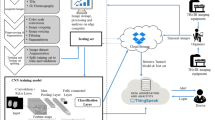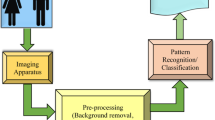Abstract
One of the challenges that arise when utilizing real-time reaction services, such as constructing deep learning models within the Internet of Medical Things (IoMT) infrastructure, is effectively balancing the computation load between the cloud and fog computing layers. This paper proposes a unified framework of offline training and online response to the healthcare professional. The framework gathers medical images from various heterogeneous IoMT devices and then arranges them into homogeneous locations in the cloud, using a stage-one classification stage (or offline training). Furthermore, the stage-two classification (or online response) is employed to detect the type of cancer for each homogeneous location containing the same image type within the cloud. To evaluate the framework, we conducted extensive experiments on six well-known cancer datasets of multiple types. The stage-one classification shows superior results of the error rates for the InceptionResNetV2 and DenseNet201 pre-trained transfer learning models of 0.33% and 0.43% with accuracy values of 99.67% and 99.57% respectively. In the stage-two classification, the results show different performances on each dataset. The point is that each dataset is organized separately which helps in studying the influence of pre-trained transfer learning models and improving their performance in the absence of intervention and bias in datasets.










Similar content being viewed by others
References
Ahmed M, Mumtaz R, Zaidi SMH, Hafeez M, Zaidi SAR, Ahmad M (2020) Distributed fog computing for internet of things (iot) based ambient data processing and analysis. Electronics 9(11):1756
Alkhawaldeh RS (2019) Dgr: gender recognition of human speech using one-dimensional conventional neural network. Sci Program 2019
Alkhawaldeh RS, Alawida M, Alshdaifat NFF, Alma’aitah W, Almasri A (2021) Ensemble deep transfer learning model for arabic (indian) handwritten digit recognition. Neural Comput & Applic 1–15
Alkhawaldeh RS, Khawaldeh S, Pervaiz U, Alawida M, Alkhawaldeh H (2019) Niml: non-intrusive machine learning-based speech quality prediction on voip networks. IET Commun 13(16):2609–2616
Amin SU, Hossain MS (2020) Edge intelligence and internet of things in healthcare: A survey. IEEE Access 9:45–59
Bajaj A, Bhatnagar M, Chauhan A (2021) Recent trends in internet of medical things: a review. Adv Mach Learn Comput Intell 645–656
Bibi N, Sikandar M, Ud Din I, Almogren A, Ali S (2020) Iomt-based automated detection and classification of leukemia using deep learning. J Healthc Eng 2020
Borkowski AA, Bui MM, Thomas LB, Wilson CP, DeLand LA, Mastorides SM (2019) Lung and colon cancer histopathological image dataset (lc25000). arXiv preprint. arXiv:1912.12142
Boumaraf S, Liu X, Zheng Z, Ma X, Ferkous C (2021) A new transfer learning based approach to magnification dependent and independent classification of breast cancer in histopathological images. Biomed Signal Process Control 63:102192. https://doi.org/10.1016/j.bspc.2020.102192. https://www.sciencedirect.com/science/article/pii/S174680942030330X
Chai J, Zeng H, Li A, Ngai EW (2021) Deep learning in computer vision: A critical review of emerging techniques and application scenarios. Mach Learn Appl 100134
Chakrabarty N (2019) Brain mri images for brain tumor detection. https://www.kaggle.com/navoneel/brain-mri-images-for-brain-tumor-detection
Chang Z, Liu S, Xiong X, Cai Z, Tu G (2021) A survey of recent advances in edge-computing-powered artificial intelligence of things. IEEE Internet Things J
Chapala V, Bojja P (2021) Iot based lung cancer detection using machine learning and cuckoo search optimization. Int J Pervasive Comput Commun
Codella NC, Gutman D, Celebi ME, Helba B, Marchetti MA, Dusza SW, Kalloo A, Liopyris K, Mishra N, Kittler H et al (2018) Skin lesion analysis toward melanoma detection: A challenge at the 2017 international symposium on biomedical imaging (isbi), hosted by the international skin imaging collaboration (isic). In: 2018 IEEE 15th international symposium on biomedical imaging (ISBI 2018), p 168–172. IEEE
Dai X, Spasić I, Meyer B, Chapman S, Andres F (2019) Machine learning on mobile: An on-device inference app for skin cancer detection. In: 2019 Fourth International Conference on Fog and Mobile Edge Computing (FMEC), p 301–305. IEEE
Esteva A, Chou K, Yeung S, Naik N, Madani A, Mottaghi A, Liu Y, Topol E, Dean J, Socher R (2021) Deep learning-enabled medical computer vision. NPJ Digit Med 4(1):1–9
Gupta KD, Sharma DK, Ahmed S, Gupta H, Gupta D, Hsu CH (2021) A novel lightweight deep learning-based histopathological image classification model for iomt. Neural Process Lett 1–24
Hayyolalam V, Aloqaily M, Ozkasap O, Guizani M (2021) Edge intelligence for empowering iot-based healthcare systems
He K, Zhang X, Ren S, Sun J (2016) Identity mappings in deep residual networks. In: European conference on computer vision, p 630–645. Springer
Hong ZQ, Yang JY (1991) Optimal discriminant plane for a small number of samples and design method of classifier on the plane. Pattern Recog 24(4):317–324
Huang G, Liu Z, Van Der Maaten L, Weinberger KQ (2017) Densely connected convolutional networks. In: Proceedings of the IEEE conference on computer vision and pattern recognition, p 4700–4708
Hussain Ali Y, Sabu Chooralil V, Balasubramanian K, Manyam RR, Kidambi Raju S, T Sadiq A, Farhan AK (2023) Optimization system based on convolutional neural network and internet of medical things for early diagnosis of lung cancer. Bioengineering 10(3). https://doi.org/10.3390/bioengineering10030320. https://www.mdpi.com/2306-5354/10/3/320
Jain S, Nehra M, Kumar R, Dilbaghi N, Hu TY, Kumar S, Kaushik A, Li Cz (2021) Internet of medical things (iomt)-integrated biosensors for point-of-care testing of infectious diseases. Biosens Bioelectron 113074
Khamparia A, Singh PK, Rani P, Samanta D, Khanna A, Bhushan B (2021) An internet of health things-driven deep learning framework for detection and classification of skin cancer using transfer learning. Trans Emerg Telecommun Technol 32(7):e3963
Khan SU, Islam N, Jan Z, Din IU, Khan A, Faheem Y (2019) An e-health care services framework for the detection and classification of breast cancer in breast cytology images as an iomt application. Futur Gener Comput Syst 98:286–296
Khan TA, Fatima A, Shahzad T, Atta-Ur-Rahman AK, Ghazal TM, Al-Sakhnini MM, Abbas S, Khan MA, Ahmed A (2023) Secure iomt for disease prediction empowered with transfer learning in healthcare 5.0, the concept and case study. IEEE Access 11:39418–39430. https://doi.org/10.1109/ACCESS.2023.3266156
Kim T, Yoo Se, Kim Y (2021) Edge/fog computing technologies for iot infrastructure. Sensors 21(9). https://doi.org/10.3390/s21093001. https://www.mdpi.com/1424-8220/21/9/3001
Kudin A (2019) C-nmc leukemia. https://www.kaggle.com/avk256/cnmc-leukemia
Kumar S, Arora AK, Gupta P, Saini BS (2021) A review of applications, security and challenges of internet of medical things. Cogn Internet Med Things Smart Healthc 1–23
Labati RD, Piuri V, Scotti F (2011) All-idb: The acute lymphoblastic leukemia image database for image processing. In: 2011 18th IEEE International Conference on Image Processing, p 2045–2048. IEEE
LeCun Y, Bengio Y, Hinton G (2015) Deep learning. Nature 521(7553):436–444
Lin J (2020) Gastrointestinal cancer msi mss prediction. https://www.kaggle.com/linjustin/train-val-test-tcga-coad-msi-mss
Luongo F, Hakim R, Nguyen JH, Anandkumar A, Hung AJ (2021) Deep learning-based computer vision to recognize and classify suturing gestures in robot-assisted surgery. Surgery 169(5):1240–1244
Masood A, Sheng B, Li P, Hou X, Wei X, Qin J, Feng D (2018) Computer-assisted decision support system in pulmonary cancer detection and stage classification on ct images. J Biomed Inform 79:117–128
Ogundokun RO, Misra S, Akinrotimi AO, Ogul H (2023) Mobilenet-svm: A lightweight deep transfer learning model to diagnose bch scans for iomt-based imaging sensors. Sensors 23(2). https://doi.org/10.3390/s23020656. https://www.mdpi.com/1424-8220/23/2/656
Ohata EF, das Chagas JVS, Bezerra GM, Hassan MM, de Albuquerque VHC, Reboucas Filho PP (2021) A novel transfer learning approach for the classification of histological images of colorectal cancer. J Supercomput 1–26
Parvathy VS, Pothiraj S, Sampson J (2021) Automated internet of medical things (iomt) based healthcare monitoring system. In: Cognitive Internet of Medical Things for Smart Healthcare, p 117–128. Springer
Pati A, Parhi M, Pattanayak BK, Sahu B, Khasim S (2023) Candiag: Fog empowered transfer deep learning based approach for cancer diagnosis. Designs 7(3). https://doi.org/10.3390/designs7030057. https://www.mdpi.com/2411-9660/7/3/57
Pradhan A, Sekhar KR, Swain G (2018) Digital image steganography using lsb substitution, pvd, and emd. Math Probl Eng 2018
Pushpa B (2021) An efficient internet of things (iot)-enabled skin lesion detection model using hybrid feature extraction with extreme machine learning model. In: Proceedings of International Conference on Intelligent Computing, Information and Control Systems, p 275–282. Springer
Rahman MA, Hossain MS (2021) An internet of medical things-enabled edge computing framework for tackling covid-19. IEEE Internet Things J
Raja Subramanian R, Vasudevan V (2021) Harfog: An ensemble deep learning model for activity recognition leveraging iot and fog architectures. In: Modern Approaches in Machine Learning and Cognitive Science: A Walkthrough, p 127–136. Springer
Rajan JP, Rajan SE, Martis RJ, Panigrahi BK (2020) Fog computing employed computer aided cancer classification system using deep neural network in internet of things based healthcare system. J Med Syst 44(2):1–10
Sadad T, Khan AR, Hussain A, Tariq U, Fati SM, Bahaj SA, Munir A (2021) Internet of medical things embedding deep learning with data augmentation for mammogram density classification. Microsc Res Tech
Saeik F, Avgeris M, Spatharakis D, Santi N, Dechouniotis D, Violos J, Leivadeas A, Athanasopoulos N, Mitton N, Papavassiliou S (2021) Task offloading in edge and cloud computing: A survey on mathematical, artificial intelligence and control theory solutions. Comput Netw 195:108177. https://doi.org/10.1016/j.comnet.2021.108177. https://www.sciencedirect.com/science/article/pii/S1389128621002322
Sahu P, Yu D, Qin H (2018) Apply lightweight deep learning on internet of things for low-cost and easy-to-access skin cancer detection. In: Medical Imaging 2018: Imaging Informatics for Healthcare, Research, and Applications, vol 10579, p. 1057912. International Society for Optics and Photonics
Sartaj: Brain tumor classification (mri) (2020). https://www.kaggle.com/sartajbhuvaji/brain-tumor-classification-mri
Spanhol FA, Oliveira LS, Petitjean C, Heutte L (2015) A dataset for breast cancer histopathological image classification. IEEE Trans Biomed Eng 63(7):1455–1462
Srinivasulu A, Ramanjaneyulu K, Neelaveni R, Karanam SR, Majji S, Jothilingam M, Patnala TR (2021) Advanced lung cancer prediction based onblockchain material using extended cnn. Appl Nanosci 1–13
Szegedy C, Ioffe S, Vanhoucke V, Alemi AA (2017) Inception-v4, inception-resnet and the impact of residual connections on learning. In: Thirty-first AAAI conference on artificial intelligence
Szegedy C, Vanhoucke V, Ioffe S, Shlens J, Wojna Z (2016) Rethinking the inception architecture for computer vision. In: Proceedings of the IEEE conference on computer vision and pattern recognition, p 2818–2826
Tschandl P, Rosendahl C, Kittler H (2018) The ham10000 dataset, a large collection of multi-source dermatoscopic images of common pigmented skin lesions. Sci Data 5(1):1–9
Wang S, Ruan Y, Tu Y, Wagle S, Brinton CG, Joe-Wong C (2021) Network-aware optimization of distributed learning for fog computing. IEEE/ACM Trans Networking
Wang Y, Nazir S, Shafiq M (2021) An overview on analyzing deep learning and transfer learning approaches for health monitoring. Comput Math Methods Med 2021
Zhang J, Qu Z, Chen C, Wang H, Zhan Y, Ye B, Guo S (2021) Edge learning: The enabling technology for distributed big data analytics in the edge. ACM Comput Surv 54(7). https://doi.org/10.1145/3464419
Funding
This work is not funded.
Author information
Authors and Affiliations
Contributions
Rami S. Alkhawaldeh and Saja Al-Dabet: Conceptualization; Rami S. Alkhawaldeh and Saja Al-Dabet: Data curation; Rami S. Alkhawaldeh: Formal analysis; Rami S. Alkhawaldeh and Saja Al-Dabet: Funding acquisition; Saja Al-Dabet: Investigation; Rami S. Alkhawaldeh and Saja Al-Dabet: Methodology; Rami S. Alkhawaldeh: Project administration; Rami S. Alkhawaldeh and Saja Al-Dabet: Resources; Rami S. Alkhawaldeh and Saja Al-Dabet: Software; Supervision; Rami S. Alkhawaldeh and Saja Al-Dabet: Validation; Rami S. Alkhawaldeh: Visualization; Rami S. Alkhawaldeh and Saja Al-Dabet: Roles/Writing - original draft; Saja Al-Dabet: Writing - review & editing
Corresponding author
Ethics declarations
Ethical approval
This article does not contain any studies with human participants or animals performed by any of the authors.
Conflict of Interest
The author(s) declare(s) that there is no conflict of interest regarding the publication of this paper.
Additional information
Publisher's Note
Springer Nature remains neutral with regard to jurisdictional claims in published maps and institutional affiliations.
Rights and permissions
Springer Nature or its licensor (e.g. a society or other partner) holds exclusive rights to this article under a publishing agreement with the author(s) or other rightsholder(s); author self-archiving of the accepted manuscript version of this article is solely governed by the terms of such publishing agreement and applicable law.
About this article
Cite this article
Alkhawaldeh, R.S., Al-Dabet, S. Unified framework model for detecting and organizing medical cancerous images in IoMT systems. Multimed Tools Appl 83, 37743–37770 (2024). https://doi.org/10.1007/s11042-023-16883-9
Received:
Revised:
Accepted:
Published:
Issue Date:
DOI: https://doi.org/10.1007/s11042-023-16883-9




